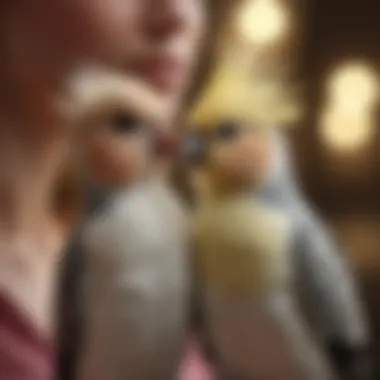Choosing the Perfect Companion Birds for You


Intro
Selecting the right companion bird requires knowledge of several factors. From understanding their needs to fostering a suitable environment, potential bird owners must recognize what is involved in leaving a fulfilling life with avian companions. The objective is to analyze firsthand how various species cater to the requirements of their humans while offering insight into maintaining their overall well-being.
Care Tips
Taking proper care of companion birds involves a blend of daily habits, cage management, and hygiene practices. By being attentive to these elements, potential bird owners can create a nurturing setting.
Daily Care Routines
Consistency is key when caring for any pet, and birds are no exception. Owners should have a daily routine that covers feeding, social interaction, and environmental enrichment. Here are key components:
- Feeding schedule: Birds thrive on routines, so establishing a regular meal time aids digestion and comfort.
- Interaction time: Birds are social creatures; especially species like parrots need times of engagement with their families.
- Exercise and playtime: It can be beneficial to allow your bird out of its cage for physical activity each day.
Cage Setup and Maintenance
Creating an ideal habitat is vital. Each bird species has its distinct cage sizing and type preferences. Basic recommendations include:
- Use spacious cages that allow for comfortable movement.
- Include perches of varying diameters to promote foot health.
- Ensure that toys stimulate mental engagement without being overly stimulating.
Regular cleaning is also crucial. Schedule cleanings every week to avoid harmful bacteria buildup and provide a fresh environment.
Hygiene and Cleaning Practices
Regular cleaning routines help to maintain a healthy setup for both the bird and its owner. Schedules can include:
- Daily cleaning: Spot clean as needed to manage droppings and uneaten food.
- Weekly deep cleaning: Take everything out of the cage to scrub surfaces and change bedding.
Seasonal Care Adjustments
Weather changes may require adjustments. In colder months, ensure heat sources stay safe and alleviate drafty locations. In hot weather, limit direct sun exposure and have clean water readily available.
Behavioral Insights
Birds communicate through behavior. Learning how to interpret these signs can enhance the pet-owner relationship.
Understanding Bird Body Language
Recognizing a bird's body language helps owners gauge feelings:
- Wings held open: Generally expresses openness, indicating the bird may want to play.
- Puffed feathers: Indicates discomfort or sleepiness.
Common Behavioral Issues and Solutions
Common troubles include biting, plucking feathers, or excessive squawking. Solutions consist of:
- Ensuring interactive engagement plenty often.
- Instilling routine behavior through consistent corrective responses.
Positive Reinforcement Techniques
Positive reinforcement rewards specific behaviors using treats or praises. This method encourages desired behaviors and builds trust.
Social Interaction Needs
Solitary confinement is unsuitable for most species. Owner participation is crucial. Consider partnering them with another bird or training them for more interactive roles.
Nutrition Guides
Bird nutrition affects behavioral health and longevity, thus owner awareness is essential.
Essential Diet Components
A typical bird diet may require (species-specific recommendations):
- Pellets: These can cover daily nutritional needs.
- Fruits and vegetables: Fresh produce is necessary for calorie and nutrients.
Safe and Toxic Foods
Birds are vulnerable to certain everyday foods. Notable toxic substances include:
- Avocado: Can lead to severe poisoning tent.
- Caffeine: Harmful to many species and leads to passage issues.
Supplements and Treats


Birds need occasional supplements, including multivitamins when necessary. Suitable variations may enhance diets without harm.
Feeding Strategies for Different Species
Establish feeding guidelines focusing on individual specifics. Smaller birds need varied seeds, while larger species benefit from direct fruit access.
Wellness and Health
Optimal wellness enhances a bird’s happy temperament.
Routine Health Checkups
Finding avian veterinarians can lead to yearly checkups. They assess general health, beak and feather conditions, and lifestyle hazards.
Identifying Symptoms of Illness
Common warning signs include; lethargy, isolation, or lack of appetite. Watch closely for abnormal behaviors that may imply underlying issues.
Preventative Care and Vaccinations
Just as with other pets, birds necessitate vaccinations from aa young age to reduce vulnerability.
Mental and Emotional Well-being
Community and happiness are essential traits; avoid creating distressing environments to uphold emotional stability.
Enriching Activities
Engagement is as necessary as sustenance for overall welfare.
Toys and Playtime Ideas
Introduce a plethora of engaging toys that cater to interest levels. Rotate new items occasionally to retain stimulation freshness.
Training and Tricks
Teaching basic tricks is fruitful. Birds possess significant potential for learning and forms an interactive bond. Abilities to mimic sounds or words excite sure audiences.
Outdoor Activities and Interaction
Fresh air time is valuable for mental and emotional advantages, but it requires enthusiasms towards safety.
DIY Projects for Mental Stimulation
Make your own gadgets from safe household materials. This encourages discovery and play. Ideas may include string-tied knickknacks or useable paper rolls.
Overall, ongoing enrichment activities are key to keeping birds happy and flourishing. Home environments filled with consideration increase satisfaction (both avian and human). This exploration aims not only enlighten prospective owners on caring tips but builds the groundwork for meaningful companionship.
Preamble to Companion Birds
Companion birds serve as fascinating and interactive pets that add joy and companionship to many households. These birds not only provide entertainment but also foster a unique bond with their owners. They exhibit various dispositions and varying levels of social interaction, which can dramatically influence one’s experience as a bird owner. Understanding the importance of choosing the right companion bird is essential for ensuring a harmonious relationship between bird and owner.
Understanding the Role of Companion Birds
As avian enthusiasts know, it's not just about owning a pet. Companion birds can enrich lives through their behavior and social interaction. They can learn to mimic sounds, display affection, and provide emotional fulfillment. Establishing a strong bond with a companion bird creates an enriching atmosphere in the home, where both the owner and the bird thrive. Birds can serve as both companions and sources of joy, helping reduce feelings of loneliness and stress. A potential owner must first comprehend these functional roles of birds to foster a positive bond.
Criteria for Choosing a Companion Bird
Selecting a companion bird requires consideration of several criterias that assure a good fit between the bird’s needs and the owner’s lifestyle. Factors include:
- Temperament: Each species possesses distinct characteristics. Some birds may be more interactive while others are independent.
- Life Span: Some companion birds, like African Grey Parrots, may live for several decades. Potential owners must be ready for a long-term commitment.
- Space Needs: Birds need enough space to fly and play. The owner’s living situation might limit the types of birds that can be brought home.
- Feeding Requirements: Different birds have varied dietary needs, impacting daily routines.
- Activity Level: Some birds require more interaction and stimulation than others. Owners should consider their own daily time commitments before making a decision.
- Noise Levels: Certain species, like cockatiels and lovebirds, can be vocal. Assessing tolerance for potential noise is important.
Popular Species of Companion Birds
Popular species of companion birds play a crucial role in defining the avian pet ownership experience. Factors like size, temperament, and individual needs influence a potential owner's choice. Selecting a companion bird suited to one's lifestyle produces an enriching partnership. In this section, we delve into specific species that stand out among bird enthusiasts. We offer detailed insights on individual characteristics, engagement levels, adaptability, and care requirements.
Parakeets: A Beginner's Choice
Parakeets are often recommended as excellent entry-level birds. They are small, colorful, and generally possess a friendly disposition. The average lifespan ranges from 5 to 10 years, making them manageable pets for beginners. They are social and often enjoy human interaction. Parakeets tend to be more forgiving of novice mistakes in care.
Owners typically appreciate their chatter, as they can mimic sounds and even a few words. Regular interaction stimulates their cognitive skills, reducing boredom. A balanced diet primarily featuring high-quality seeds, pellets, and fresh vegetables is essential. Their lively nature makes them a joy to watch, ensuring a delightful companion experience.
Cockatiels: Social and Affectionate
Cockatiels are known for their affectionate personality traits. These birds are approximately 12 to 14 inches long and exhibit various color mutations. Their sweet vocalizations create a serene atmosphere, making them highly sought after. A strong need for social interaction means they bond closely with their owners.


It's important to foster a nurturing environment that engages them. Their diet should consist of pellets, a selection of fruits, and greenery. Regular out-of-cage time helps them exercise and interact with family members, enhancing the bond with their companions. This species thrives on companionship and responds positively to love and consistency from their human caregivers.
Lovebirds: The Small but Mighty Companions
Despite their small stature, lovebirds are known for their vibrant personalities. They thrive in pairs or small groups, showcasing their social nature. The bonding behavior displayed between two lovebirds can be heartwarming. Their average lifespan ranges from 10 to 15 years, ensuring a lasting connection.
It's essential to be prepared for their energy levels; they need plenty of mental stimulation and space to explore. An appropriate diet includes pellets, seed mixes, and ample fresh fruits. Lovebirds require safe toys that encourage playfulness, providing mental enrichment. Their presence can uplift a home effortlessly if cared for properly.
Budgerigars: Colorful and Lively
Budgerigars, commonly called budgies, are captivating due to their colorful plumage and playful demeanor. They come in various shades, each beautifully adorned. Budgies typically reach sizes between 7 to 9 inches. They possess friendly and lively temperaments that suit various households, becoming courageous little companions.
Providing them with ample toys and perches will help satisfy their need to stay engaged. A well-rounded diet is key; filling it with seeds, nutritious pellets, and a variety of bean mixtures will promote overall health. Watching them interact with each other and their environment can provide unparalleled fascination.
African Grey Parrots: Intelligent and Engaging
The African Grey Parrot is well-regarded for its high intelligence and vocal abilities. They are particularly noted for potential mimicry of speech, making their owners deeply intrigued. These majestic birds require more commitment in terms of care. Their lifespans can extend up to 40 years, signifying a long-term pet responsibility.
Engagement through puzzles and toys that challenge their intelligence is necessary. Their nutritional needs vary but require an array of fruits, vegetables, grains, and specially formulated pellets. Social interactions are vigor since the absence can lead to behavioral issues. Hence, African Grey Parrots significantly enrich the lives of those ready for their challenges and commitments.
Assessing Behavioral Traits
Assessing the behavioral traits of companion birds is crucial when selecting the right feathered pet. Understanding these traits aids potential owners in making well-informed choices that match their lifestyles. Each species displays unique behaviors which are intertwined with their temperament, social structure, and habitat needs. This article seeks to shed light on the key behavioral characteristics to look for and evaluate.
Social Interaction and Bonding
Social interaction is a vital aspect of a bird's well-being. Many companion birds thrive on time spent with their human caregivers. This interaction creates a bond that can enhance the quality of life for both the bird and the owner. Different species have varying social needs. For instance, African Grey Parrots and Cockatiels tend to be more affectionate and heavily reliant on companionship, while Budgerigars may enjoy socializing but are slightly more independent.
When assessing social interaction preferences, consider the following:
- Personality of the Bird: Some birds love constant interaction while others prefer short bursts of engagement.
- Time Availability: Potential owners must be realistic about the time they can spend with their pet bird daily.
Building a strong bond requires regular interaction. Feeding, talking, and offering training sessions are effective ways to cement this relationship. Quality time can lead to reduced stress in birds, overall happiness, and a “happy” bird often translates to a more vibrant and interactive companionship.
Vocalization Patterns
Birds are known for their vocal tendencies. Vocalization varies widely across species, from the engaging whistles of Lovebirds to the sophisticated mimicry of African Grey Parrots. Understanding vocalization patterns becomes essential for determiningcompatibility between the potential bird owner and their chosen pet.
Key points to consider:
- Learning Capabilities: Some birds can learn and mimic human speech, greatly enhancing interaction.
- Noisy Behavior: Owners should be aware that certain species can be loud, potentially leading to conflicts in living environments. Cockatiels, for example, may emit loud whistles or calls at various times.
It’s beneficial to observe a bird’s vocalization habits before adoption to ensure a match. A noisy bird may not suit individuals living in close quarters or shared environments.
Playfulness and Activity Levels
The playfulness and activity levels of companion birds often reflect overall mental and emotional health. Bird owners need to recognize which breeds are inclined to active play vs. those that are relaxed. Higher activity engagement fosters mental stimulation and adds texture to a bird’s life.
Important Elements in Playfulness and Activity:
- Physical Exercise: Birds like Parakeets and Lovebirds need ample opportunity to exert energy through toys, climbing, and playtime outside their cages.
- Social Play: Some birds enjoy interacting with toys as well as their caregivers.
Caregivers should create an environment rich with stimulating toys. Oftentimes, boredom can lead to unintended behaviors. Recognizing patterns in play helps foster a positive and fulfilling relationship.
By analyzing these behavioral traits—social interaction, vocalization tendencies, and playfulness—aspiring bird owners can ensure their new pet will be a compatible and fulfilling addition to their lives.
Care Essentials for Companion Birds
Caring for companion birds requires more than just providing a safe space. It demands a deep understanding of their necessary needs and key factors that contribute to their well-being. Prospective bird owners should prioritize the essentials to ensure a fulfilled and guide the happiness of their feathered friends. Proper care also impacts bonding, as a bird feels more secure and happy within a well-maintained environment. Key elements include diet, housing, and health care, forming the foundation of a nurturing avian household.
Dietary Requirements
A balanced diet is essential for the health of companion birds. Most birds thrive on a mixture of seeds, pellets, and fresh fruits and vegetables. Each bird species has unique nutrional requirements, so it is important to research specific dietary needs.
- Seeds and Pellets: High-quality pellets offer a good balance of nutrients. Seeds should be offered in moderation, as they can be high in fat. An exclusive seed diet can lead to nutritional imbalances.
- Fruits and Vegetables: Fresh produce enhances the vitamin intake. Common options include leafy greens, carrots, and apples, the majority providing hydration.
- Avoiding Toxic Foods: While feeding, be aware of toxic items. Avocados, chocolate, and onions pose risks. Consult resources for a complete list of harmful foods.
Well fed companion birds are vitality and vivid. Drafting a typical meal plan can guide the feeding habits and balance examinations. Strategies on food habits can promote healthy eating.
Housing and Environment
Providing an appropriate housing environment is paramount for a bird's emotional and physical health. The habitat must be both functional and stimulating.
- Cage Size and Shape: The cage should be spacious enough for the bird to move freely. Height is often more significant than width for climbing species.
- Bedding and Accessories: Use suitable bedding material like paper or aspen shavings. Include perches made of various materials and textures to prevent boredom and maintain foot health.
- Ventilation and Location: Birds need good air flow and clean environments. The housing position matters—avoid areas with harsh drafts, and ensure primary light access without direct sunlight overexposure.
- Cleaning: Regular cleaning prevents the growth of harmful bacteria. Maintaining the cage environment promotes longevity and reduces risks of illness.
- Toys should be varied and rotated to keep engaging.


Attention to the living habitat reflects the overall health and happiness of the bird. A comfortable environment helps establish trust.
Health Care and Veterinary Considerations
Preventive health care can identify potential issues before becoming serious. This requires diligent effort from bird owners.
- Routine Check-ups: Schedule periodic veterinary appointments to assess health—this becomes even more important for older birds.
- Signs of Illness: Understanding common symptoms can be crucial. Noticeable signs of distress like changes in behavoir, poor appetite or unusual vocalization warrant immediate consultation.
- Proper Vaccinations: Some species can benefit from vaccinations. A qualified veterinarian can suggest appropriate treatments to protect against common diseases.
A crucial part of care is consistency. Developing strong habits alongside knowledge ensures the long-term health of your avian companion.
Remember: Investing time in understanding care requirements will result in a happier and healthier bond that you will cherish.
Following attention to these essentials can enhance the experience of being a pet parent and allow you to connect better with your special feathered friend.
Understanding Companionship Needs
The significance of understanding companionship needs in the realm of pet birds is substantial. Companion birds require not just physical care, but also emotional and social fulfillment. Birds, being inherently social creatures, thrive in environments where they receive adequate interaction from their human caretakers. This section will address the vital components of companionship needs, particularly the time commitment and issues of social compatibility with other pets.
Time Commitment and Interaction
Owning a companion bird is not a fleeting hobby; it demands a commitment that can span years, or even decades. Each bird species exhibits unique needs regarding interaction. For instance, a Cockatiel often enjoys regular engagement with its owner while a more independent finch might require less interaction.
Here are some key aspects regarding time commitment:
- Daily Interaction Requirements: Most birds require several hours of social engagement each day to prevent boredom and stress. This interaction is crucial for promoting mental well-being and ensuring an affectionate relationship.
- Structured Routine: Establishing a consistent routine can help ease the bird's anxiety. Birds feel secure with predictability in activities, feeding, and human interaction.
- Active Participation: Engagement doesn’t end with feeding and cleaning. Activities such as playtime outside the cage can be paramount. Birds often express their health and happiness through their eagerness during these interactions.
Furthermore, neglecting these commitments can lead to issues such as behavioral problems. These might include excessive screeching, plucking feathers, or aggression. Bird owners should be prepared to create a stimulating atmosphere that keep their avian companions satisfied and engaged.
Social Compatibility with Other Pets
When considering the inclusion of a bird into a household, social compatibility with existing pets is a critical factor. Birds exhibit distinct behaviors that may not blend well with some animals. Understanding these social dynamics helps in ensuring a harmonious living environment.
Here are some points of consideration:
- Bird Personality vs. Pet Types: Certain birds, like lovebirds, may display more assertive behaviors. When introducing them around cats or dogs, a cautious approach is necessary. Major breaks may be needed to allow proper introductions.
- Environment Design: It means creating zones in your home where your bird feels safe from potential threats, while still enabling visibility of other pets. Cages can often be built to facilitate this.
- Supervised Interactions: Always supervise any interaction between your bird and other pets during initial introductions. Observing behaviors during these times provides valuable insight into compatibility and potential issues.
The aim is to create a setting where all pets can coexist peacefully and safely.
Understanding these facets of companionship needs ultimately shapes the enriching experience of owning a pet bird. When a bird receives adequate interaction and a well-designed environment, the bond between human and avian companion is strengthened, leading to mutual enjoyment and happiness.
Enhancing the Bond with Your Bird
Building a solid rapport with your companion bird is crucial. A strong bond allows for effective communication and trust between you and your feathered friend. It offers benefits that are multi-faceted. Not only does it create a more enjoyable experience for pet owners, it also improves the overall well-being of the bird. Companion birds are social creatures that thrive on interaction. Developing a closer relationship leads to well-adjusted and happier birds.
Training and Enrichment Activities
Engaging your bird with training and enrichment activities plays a critical role in fostering a good relationship. This involves several approaches. Basic training, such as teaching the bird to perch on your finger or respond to commands, increases trust. These interactions help establish a framework of cooperation and understanding.
Activities to Consider:
- Clicker Training: This method uses a sound to signal desired behaviors, followed by a reward. It encourages learning and strengthens the bond between you and your bird.
- Interactive Toys: Offering toys that stimulate problem solving keeps your bird entertained. Choice is important. Each bird has individual preferences.
- Out-of-Cage Time: Allow during supervised periods outside their cage. This provides an opportunity for exercise and further interaction, promoting a sense of adventure and comfort in your presence.
Provide variety and consistency in activities. This not only entertains your bird but also keeps them mentally stimulated, crucial for their overall health.
Understanding Body Language
Another aspect of enhancing the bond involves paying attention to your bird’s body language. Birds communicate significantly through posture, beak positions, and feather conditions. Therefore, discerning these signs can tell you much. Understanding when your bird feels comfortable or stressed aids in effective interaction.
Common Body Language Indicators:
- Relaxed Feather Position: This typically signifies a content and comfortable bird. Discreetly covering up or fluffing up feathers may be normal.
- Beak Grinding: A sign that your bird is content, similar to a cat purring.
- Tail Feathers Spread Wide: This can indicate excitement or readiness to play.
Always remain observant. Recording your bird’s behaviors and reactions aids not only in enhancing your bond but also helps you tailor your activities to your bird's personality.
Developing an understanding of your bird and providing activities is integral in building a satisfying relationship. The effort put into this bond is undeniably rewarding, as the connection between a bird and its owner provides joy for both parties.
The End
Choosing the right companion bird is a significant decision that involves multiple factors. Understanding these factors is crucial for the health and happiness of both the bird and its owner. This article covers the essentials of selectng companion birds, from the behavioral traits to care and companionship needs.
Final Thoughts on Choosing the Right Companion Bird
Opting for a companion bird requires careful thought. It is important to reflect on your lifestyle and the traits of specific bird species. Here are some key elements to consider:
- Personality Fit: Ensure the bird's temperament aligns with your own. Some birds are social, while others enjoy solitude. Know your preference.
- Level of Care: Different species have varying care requirements. Research the needs to understand the time and resources needed for proper care. For example, African Grey parrots are intelligent but require more mental stimulation than parakeets.
- Long-Term Commitment: Birds can live for many years, particularly larger species. Look at your long-term plans before deciding. This is not just a temporary choice but could last several decades.
The bond you form with your companion bird can have profound benefits for mental well-being and companionship.
- Living Arrangements: Consider your environment. Some birds need larger spaces to fly and play. Assess your home to see if it can accommodate the bird's requirements.
- Health Considerations: Birds can have specific health issues based on species. Be prepared for veterinary care or dietary adjustments as required.
Being informed about these aspects enhances the relationship between the owner and the bird. Engaging in proper practices during initial bonding and throughout the pet's life enriches the experience for avian enthusiasts and significantly shapes bird welfare. In the scope of aviculture, details matter. An informed choice puts the owners and birds on a fulfilling path together.















